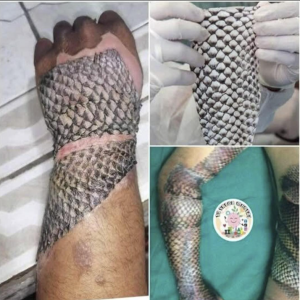
Tilapia Skin: An Innovative Alternative for Burn Recovery 🐟🔥💉
Burn injuries are among the most painful and challenging conditions to treat in medical practice. Severe burns can destroy the skin, leaving patients vulnerable to infections, dehydration, and prolonged healing periods. Traditional treatments, such as autografts (transplanting the patient’s own skin) or synthetic dressings, have limitations, including donor site pain, limited availability, and high costs. In recent years, however, a surprising and innovative solution has emerged: tilapia skin. Researchers and clinicians are exploring the use of tilapia fish skin as a viable alternative for burn recovery, providing hope for millions of patients worldwide.
Tilapia skin is rich in collagen, a key protein that promotes wound healing. Collagen is essential for skin regeneration because it provides structural support, encourages cell growth, and helps maintain moisture in the wound area. Unlike synthetic dressings, tilapia skin naturally contains high amounts of type I collagen, which closely resembles human skin. This similarity allows the fish skin to adhere effectively to the burn wound, creating a protective layer while stimulating tissue regeneration 🐟🩹💪.
The process of preparing tilapia skin for medical use involves careful cleaning and sterilization. The skin is thoroughly washed to remove scales, blood, and any potential pathogens. It is then sterilized using gamma radiation or other approved methods to ensure it is safe for human application. Once prepared, the tilapia skin acts as a temporary biological dressing that covers the burn wound, reduces pain, and protects against infection.
One of the most remarkable benefits of tilapia skin is its ability to reduce pain in burn patients. Severe burns often expose nerve endings, making even the simplest touch excruciating. Tilapia skin’s collagen-rich layer acts as a natural barrier, shielding nerve endings from air exposure and friction. Patients treated with tilapia skin dressings have reported significantly less pain compared to those using conventional gauze or synthetic dressings. This reduction in pain can decrease the need for strong painkillers and improve overall patient comfort, an essential factor in recovery 🐟❤️🩺.
Clinical studies in several countries have demonstrated the effectiveness of tilapia skin in burn care. In Brazil, where research on this method has been particularly extensive, patients with second-degree burns experienced faster healing times when treated with tilapia skin compared to traditional methods. The fish skin adhered well to wounds, maintained moisture, and promoted tissue regeneration. On average, healing time was reduced by several days, which is significant in burn care, where prolonged healing can lead to infections and scarring.
Tilapia skin also offers a cost-effective solution, especially for developing countries. Traditional treatments, such as cadaver skin or synthetic dressings, can be expensive and difficult to obtain. Tilapia, on the other hand, is widely available in many parts of the world. Using fish skin not only reduces the cost of treatment but also provides an environmentally sustainable alternative by repurposing a byproduct of the food industry 🌍💰🐟.
Another advantage of tilapia skin is its ability to retain moisture. Burns often leave skin dry and fragile, slowing the healing process. The natural collagen in tilapia skin helps maintain a moist environment, which is critical for cell proliferation and wound closure. Unlike synthetic dressings that may dry out or require frequent changes, tilapia skin can remain on the wound for several days, reducing discomfort and minimizing disruption to the healing process.
Despite its promise, tilapia skin treatment is not without challenges. Sterilization and proper preparation are critical to prevent infections. Additionally, some patients may have cultural or personal objections to using animal-derived products on their bodies. Researchers are exploring ways to address these concerns, including developing synthetic collagen dressings that mimic the benefits of tilapia skin. However, for many patients, especially in regions where other options are limited, tilapia skin represents a groundbreaking and life-saving alternative.
The adoption of tilapia skin in burn care is gradually gaining recognition worldwide. Hospitals in countries such as Brazil, Mexico, and Malaysia have begun implementing this treatment as part of standard burn care protocols. Reports indicate high patient satisfaction, reduced hospital stays, and lower treatment costs. Furthermore, international collaborations are underway to standardize preparation methods and ensure the safety and efficacy of tilapia skin dressings across different healthcare settings 🌐🏥🐟.
Tilapia skin treatment also opens new possibilities for research in regenerative medicine. Scientists are investigating whether other fish skins or marine collagen sources could offer similar benefits. The success of tilapia skin demonstrates the potential of biologically derived materials in wound care, suggesting that nature may hold untapped solutions for some of the most challenging medical problems.
In addition to burns, tilapia skin may have applications in other types of wounds, such as chronic ulcers, surgical wounds, and traumatic injuries. Its natural composition, biocompatibility, and structural properties make it an attractive candidate for a variety of medical uses. Future studies may expand its applications, further integrating marine-derived materials into mainstream healthcare.
Patient testimonials highlight the transformative impact of tilapia skin treatment. Many describe relief from constant pain, faster healing, and reduced scarring. Families express gratitude for the accessibility and affordability of the treatment, which allows patients to recover more comfortably and return to daily life sooner. Doctors emphasize the importance of combining tilapia skin with proper wound care, hydration, and nutrition to optimize outcomes.
In conclusion, tilapia skin represents a remarkable and innovative advancement in burn recovery. Its rich collagen content, pain-reducing properties, moisture retention, and cost-effectiveness make it a highly attractive alternative to traditional treatments. While challenges remain, including proper sterilization and cultural acceptance, the success of tilapia skin demonstrates the power of thinking outside the box in medical care 🐟🔥🩹.
As research continues and awareness grows, tilapia skin may become a standard option for burn patients around the world, providing faster healing, reduced pain, and a better quality of life. It serves as a reminder that sometimes, the solutions to complex medical problems can be found in unexpected places — even at the bottom of a fish tank.
The journey of tilapia skin from local fish markets to hospital burn units exemplifies the intersection of innovation, biology, and compassion. It is a story of hope for patients, a testament to human ingenuity, and an example of how nature can inspire breakthroughs in medicine. For burn victims worldwide, tilapia skin offers not just healing, but a chance to regain comfort, dignity, and the promise of a healthier future 🌟🐟❤️.

